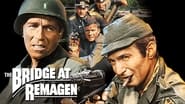deram-77963
Near the end of WW2 European theater was very bad for the Americans and Germans and I think this movie brings this out
grantss
March, 1945. The allies are closing in on Nazi Germany. The problem for the Americans and British on the Western Front is crossing the Rhine River, a natural obstacle to the invasion of Germany. The Germans have blown all of the bridges on the Rhine, except one - the bridge at Remagen. US forces are headed for it, spearheaded by a platoon lead by war-weary Lt Hartman. The Germans have sent a top-notch infantry officer, Major Kreuger, to take over the defense of the bridge and blow it up. The confrontation between the two could hasten the end of the war, or result in tens of thousands more casualties.Great WW2 drama, based on historic events. Very gritty, especially for its time. Quite realistic in its portrayal of the cynicism of the average soldier - it wasn't all unthinking, selfless courage, blindly following orders, flag-waving and gung-ho-ness. Probably quite novel in that regard, at the time.Great action scenes, with reasonably accurate equipment. No post- WW2 tanks or, worst of all, US tanks masquerading as German tanks.Solid performances, with George Segal (as Lt Hartman) to the fore. Very entertaining.
zardoz-13
"Blue Max" director John Guillermin's military action thriller "The Bridge at Remagen," with George Segal, Robert Vaughn, and Ben Gazzara, ranks at a good World War II movie. Clearly from the attitude of the U.S. Army soldiers—not their pompous superiors—these G.I. Joes see combat as a dirty business that you can get you killed. No doubt, the disillusion that most Americans had with Vietnam had tainted the storytelling. The Richard Yates & William Roberts screenplay has U.S. Brig. Gen. Shinner (E.G. Marshall) sending soldiers from Major Barnes' command (Bradford Dillman) into "Indian country" to capture 50-thousand German soldiers. Guillermin's movie shifts back and forth between the U.S. Army—the Brits and French have nothing to do with what being blown up or shot at here—the German Army. The German General Staff wants General Von Brock (Peter van Eyck of "Shakalo") to destroy the bridge so the Americans will not have a highway into the Third Reich. Naturally, Von Brock is horrified at the cost; 75-thousand German soldiers will be trapped behind the lines. Von Brock balks at the order and now must sign it to assure that he will carry it out. Von Brock assigns the inevitable task to destroying the bridge to German Major Paul Kreuger (Robert Vaughn of "The Magnificent Seven"). Like most 1960's World War II film post-"The Young Lions," Kreuger is treated as a sympathetic character with a daunting task. Of course, history dictates that Kreuger will not be able to hold the bridge, so suspense is limited in most respects. Nevertheless, the logistics of the action scenes, a robust cast, Elmer Bernstein's atmospheric orchestral score, Stanley Cortez's crisp, wide-screen cinematography, and an anti-heroic tone make "The Bridge at Remagen" a movie worth watching. Segal's Lieutenant Phil Hartman is the kind of character that Tom Hanks might have played. Ben Gazzara's skulduggery as a souvenir collector strikes the right tone for the anti-war era during which the film was made. World War II fanatics may complain about the post-World War tanks that turn up here, too. The armored vehicles look like they are hauling butt a little too fast in the opening credits, but it creates momentum. The irony is what happens to the German Major. Although it has nowhere near the scale of "The Longest Day," "The Bridge at Remagen" is a must-see for World War II moviegoers.
PamelaShort
Although The Bridge at Remagen is a highly-fictionalized account of the actual events leading up to the U.S. 9th Armored Division's approach to secure and capture the bridge during the last months of World War II , this film is extremely well done. With outstanding, solid lead performances delivered by George Segal, Robert Vaughn, Ben Gazzara and fine supporting acting by E.G Marshall, Bradford Dillman, Peter Van Eyck, and those familiar with actress Anna Gael, will find her brief performance titillating.The film is full of griping action, with a balance of the emotionally, frustrating tension suffered by the Americans and Germans, as they struggle to follow a series of exasperating orders from their commanders while enduring the grisly conditions of war. Directed by John Guillermin and filmed on location in Czechoslovakia with an excellent music score by Elmer Bernstein, this 1969 film has held up well and is still very entertaining to watch.








